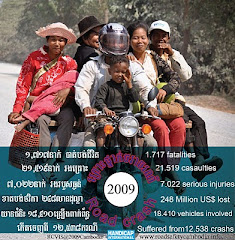
Development of National Traffic Law Enforcement Action Plan
Venue: Cambodiana Hotel
In 2007, an estimated 1,545 people were killed and 7,150 severely injured in road accidents in
To reduce road accidents, injuries and deaths, the Royal Government of Cambodia passed a landmark road traffic law in December 2006 which came into force in September 2007. Now, to improve the effectiveness of traffic law enforcement nationwide, the Ministry of Interior, and the National Police Commissariat in partnership with Handicap International Belgium and Global Road Safety Partnership are conducting two workshops from august 27-29th, 2008 aimed at developing a national traffic law enforcement strategy and action plan.
The goals of the three-day workshop are:
· To ensure high-level national police support for the strengthening of traffic law enforcement;
· To comprehend and identify effective strategic approaches, plans and operations to traffic policing in Cambodia and develop a national enforcement action plan;
· To train traffic police officers on traffic law enforcement and good practice policing methods focused on reducing road fatalities.
Participants will include members of the Ministry of Interior, National Police Commissariat, Traffic Police, National Road Safety Committee, Land Transport Department, Ministry of Justice as well as concerned non-governmental organizations and private companies. The workshop will be facilitated by international police experts from Australia with extensive experience working with national police throughout Asia.
The national traffic law enforcement strategy and action plan will aim to set enforcement objectives, priorities, actions and timelines for the traffic police, and provide the basis for operational police trainings and resource procurement.
A key focus will be on developing and prioritizing enforcement strategies and measures that target proven accident and casualty risks such as non-helmet wearing, speeding, drink-driving, non-seatbelt wearing and overloading.
It is expected that following the approval of the national traffic law enforcement strategy and action plan by the Ministry of Interior, training programmes will be set up in late 2008 by the National Traffic Police targeting specific traffic offences as defined and prioritized in the enforcement action plan.

No comments:
Post a Comment